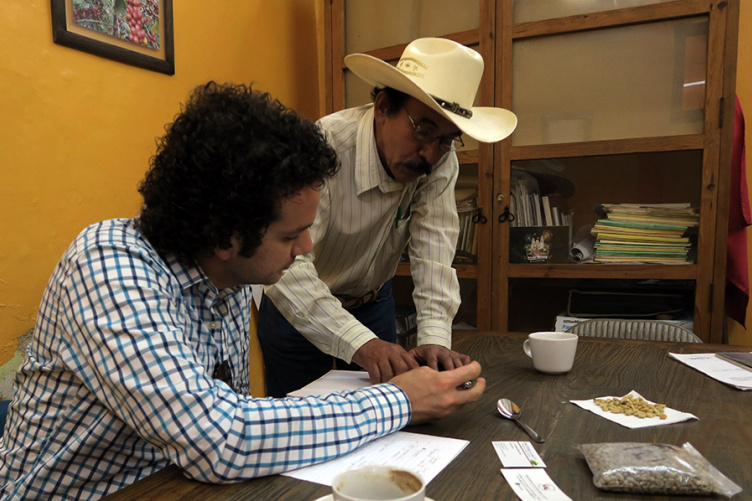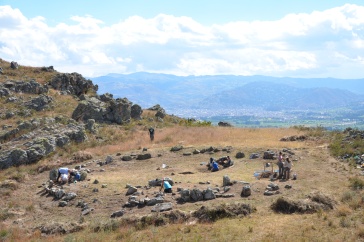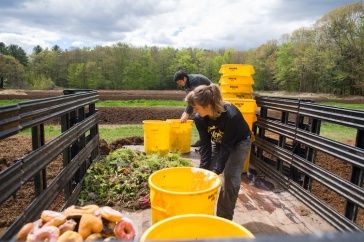
Shadi Atallah talks with a coffee grower about access to international specialty coffee markets that offer price premiums.
Cappuccino, espresso, latte, macchiato, plain old coffee, iced, frozen or hot: whatever the preference, many of us probably can’t imagine starting the day without a beverage made from coffee beans. Worldwide, people drink more than 500 billion cups of coffee every year and demand for coffee — specifically specialty coffee — is growing.
But if you think that makes coffee bean farming a lucrative business, think again. Coffee farmers face all sorts of risks, ranging from price volatility to climate change impacts.
Recent research by UNH environmental and resource economist Shadi Atallah found that one way thought to protect coffee farmers from a warming climate and boost their bottom line — growing their coffee in 40-percent shade, which can earn them a “bird friendly” price premium — constitutes an ecological win but can mean an economic loss for farmers. His findings could inform the development of certification premiums that incentivize nature-based solutions to climate adaptation and produce global environmental benefits but in a way that does not leave growers worse off.

“The bottom line is that, under many conditions, it is not economically feasible for a small farmer to increase their farm’s shading level to 40 percent even if it is ecologically beneficial for their farm,” says Atallah, assistant professor in the department of natural resources and the environment at UNH. “With the current price premiums in the market, costs of certification and costs of maintaining shade trees, it is not economically justified for a small farmer.” He summarizes his work in a paper recently published in Ecological Economics titled "A Bioeconomic Model of Ecosystem Services Provision: Coffee Berry Borer and Shade-grown Coffee in Colombia."
While coffee farms provide an economic livelihood for more than 25 million people within the “bean belt” between the Tropics of Cancer and Capricorn, many are small agricultural enterprises — less than five acres —and operate at a breakeven point.
And climate change isn’t helping their bottom line. As average temperatures rise, so does the prevalence of diseases and pests such as the destructive coffee berry borer.
But thanks to certain certifying organizations, farmers can earn a premium for their coffee if it’s grown under sustainable conditions that have ecological benefits like increasing biodiversity and reducing the need for pesticides and fertilizers.
For example, the Smithsonian’s Migratory Bird Center offers a “bird friendly” certification for coffee that’s grown on a farm with 40 percent shade because the trees create a habitat for birds. There are other benefits to a shade-grown system as well: Shade can improve coffee quality, reduce coffee berry borer infestation and increase soil fertility and water availability.
Combined with the price premium, certification sounds like a good deal for struggling farmers. Atallah found otherwise, unless price premiums are higher or certification costs are lower.
Atallah, who focused on small farms in Colombia, worked with entomologists and economists to create a computational model that simulates a small coffee farm where yields are affected by shading levels and coffee berry borer infestations, and farm profits are determined by price premiums available for “bird friendly” coffee in the marketplace and timber produced on the shade-grown farm.
Using this model, Atallah and his team, which included Miguel Gomez from Cornell’s Dyson School of Applied Economics and Management and Julianna Jaramillo from Bayer CropScience, found the shade level that offers farmers the most economic benefit is around 25 percent — 15 percent lower than the Migratory Bird Center’s requirement — even with the price premium.
Atallah refers to the Migratory Bird Center’s figure as a “socially optimal” percentage, which responds to bird habitat conservation goals and the demands of well-meaning consumers but doesn’t take into account the economic tradeoffs faced by small farmers.
“I don't think that certifiers are aware that these requirements can hurt farmers’ economic bottom line,” says Atallah. “The thinking is ‘Of course it’s going to be good for farmers because a [shade-grown system offers] pest control services and soil fertility services,’ but I'm hoping that once they see this research, they can appreciate the importance of using integrated ecological-economic frameworks when they define these premiums and how the requirements for certification.”
Atallah presented his research findings to the coffee industry at the Specialty Coffee Association Expo in Seattle on April 21 during a panel titled “Resilient Coffee?: What ‘Resilience’ Means & Why This Matters for All Members of Coffee’s Supply Chain.”
Atallah’s computational model can be applied to other locations where climate and geography produce different ecological relationships between shade and yield, and he hopes the work will benefit more than just the farmers in Colombia.
“The reality is we cannot follow only ecological objectives when it affects the livelihood of a small farmer who's at the poverty line,” he says.
Learn more about UNH's department of natural resources and the environment.
-
Written By:
Sarah Schaier | College of Life Sciences and Agriculture

















































